|
Diversify your investment portfolio even while markets rebound 3 Sep 2020 
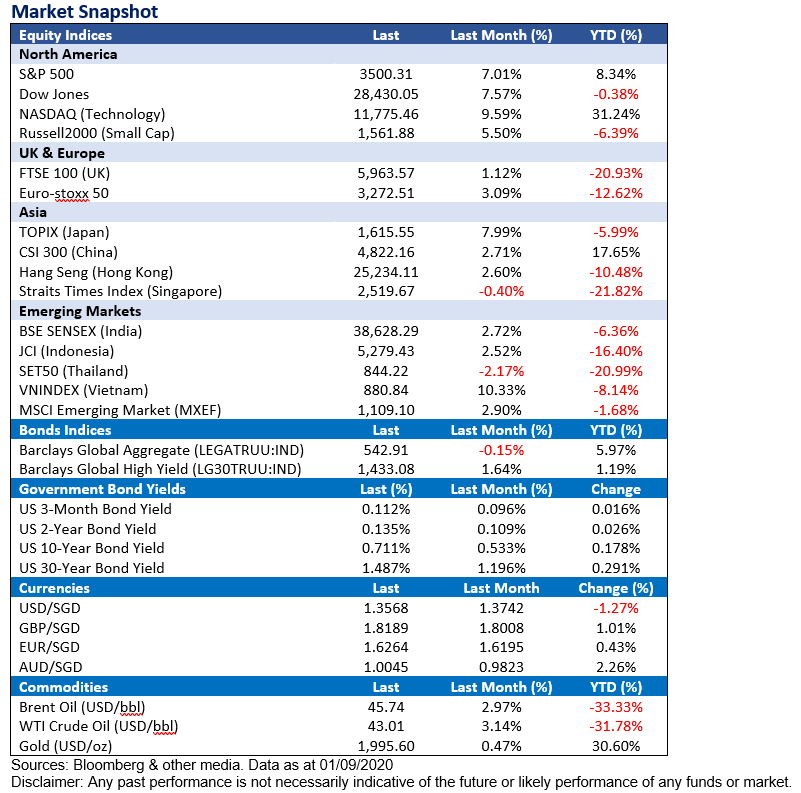
Global stock markets seemed to have hit an all-time high towards the end of August. This bull market has seen equities quickly shaking off their virus-driven losses and has not shown any signs of slowing down.2 Despite the bull run, a survey conducted by National Association for Business Economics shows that there’s a 1-in-4 chance the economy could fall into a double-dip recession.3
However, global trade flows which collapsed as coronavirus lockdowns disrupted air and sea transport and dealt a blow to the demand for many consumer and investment goods have emerged signs of a rebound in the movement of goods across national borders in the recent weeks.4 The enormous economic and social disruptions caused by the pandemic are forcing businesses and policymakers to rethink how supply chains function today.5
Central bankers in most economies have announced large stimulus programs in the last few months to avoid panic in the markets.1 Macroeconomic challenge this year is vastly different, with the IMF forecasting a 4.9 per cent contraction in global output due to the coronavirus, the worst performance since the early 1980s.
Having rushed to engineer a massive policy response to the initial virus shock which briefly threatened to unleash a financial crisis, the world’s leading central banks face the next economic phase of the pandemic with a dwindling arsenal of monetary weapons and rising frustration that some key drivers of the recovery — both health and fiscal — are beyond their control.6 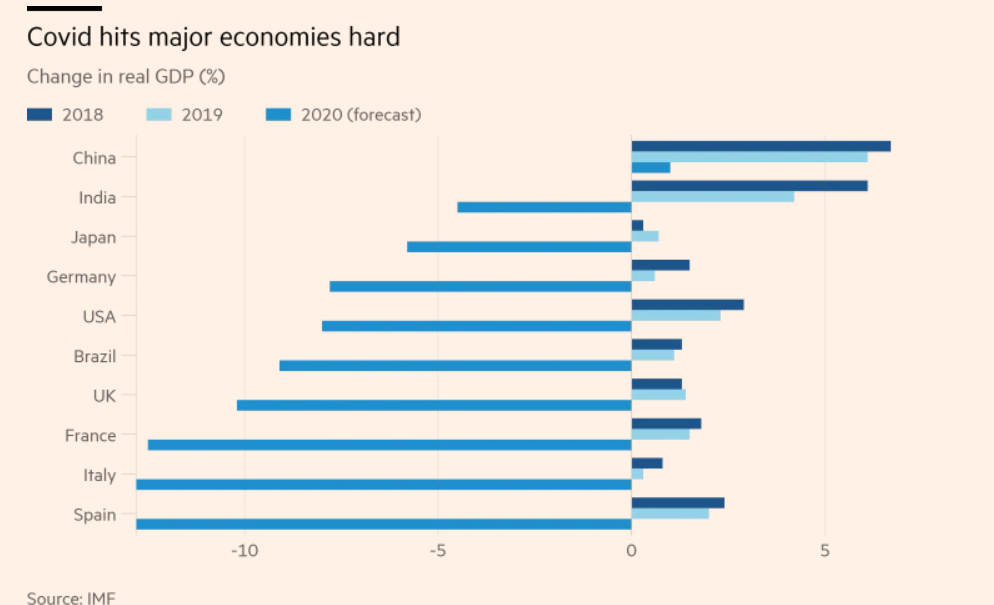
In the United States, the benchmark S&P500 is up 54% since bottoming in March, roughly where it was prior to the crisis. One could argue that the massive decline in prices early in the crisis reflected concern that the economy was severely contracting, leading to a sharp decline in profitability. Then, once it became clear that there was a path to recovery, investors bet on a return to normalcy. So, is this a bull market or simply the end of a detour? After all, the forward-looking price-to-earnings ratio for the market is now at the highest level since the tech boom early in this century.5
United States The recent rally in US equities is narrowly focused in the tech sector by FAAMG (Facebook, Apple, Amazon, Microsoft, Google), these 5 stocks accounts for about 23% of the entire market cap of S&P500 (Aug 2020).31 That said, market is pricing in negative growth in the entire US stock market excluding the 5 companies. 
U.S. unemployment rate remains low U.S. consumer confidence has also fallen to a more than six-year low in the month of August amid concerns about labour market prospects. Stringent measures to contain the spread of Covid-19 have impacted businesses worldwide, with many forced to close their doors for months. As a result, unemployment levels are on the rise with constant uncertainty on how many companies will manage to survive the ongoing shock.7
The impact of Covid-19 is the obvious leading factor as to why corporations are deciding to slash jobs. More than half of respondents from the CNBC Global CFO Council Q3 survey say they will be decreasing the number of employees over the next 12 months; just under 32% of North America respondents anticipate a reduction in their workforce.12 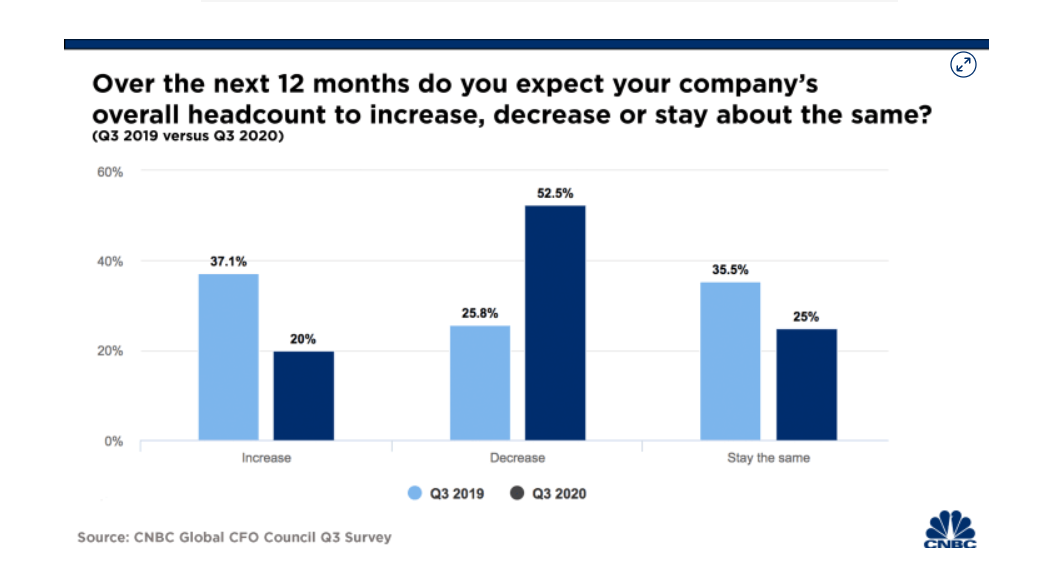
In the most recent Fed's annual Jackson Hole symposium, Powell outlined that the Fed would aim for inflation averaging 2%, with shortfalls under 2% to be compensated for by periods with inflation “moderately above 2%”. Based on its preferred measure, inflation has run short of that 2% target. The key implication is that the Fed would be slower to raise interest rates, which in turn would allow unemployment to remain lower.8
US presidential election
The US presidential race enters a three-month sprint to election day, with the candidates facing off a few times to debate each other. Both Joe Biden, the Democratic nominee, and Trump, the incumbent president, intend to hit some of the classic campaign notes from now until 3 November, while working behind the scenes to press their perceived advantages in a most unusual election year.
One major crossroads will arrive with the first presidential debate, scheduled for 29 September, with two more to follow in October. The debates offer voters the first opportunity to see how the two candidates interact, and to judge them side by side.10
Seventy-five percent of the CNBC Global CFO Council say Joe Biden will win the U.S. Presidential election in November, according to the latest quarterly survey of members released on 28 August. 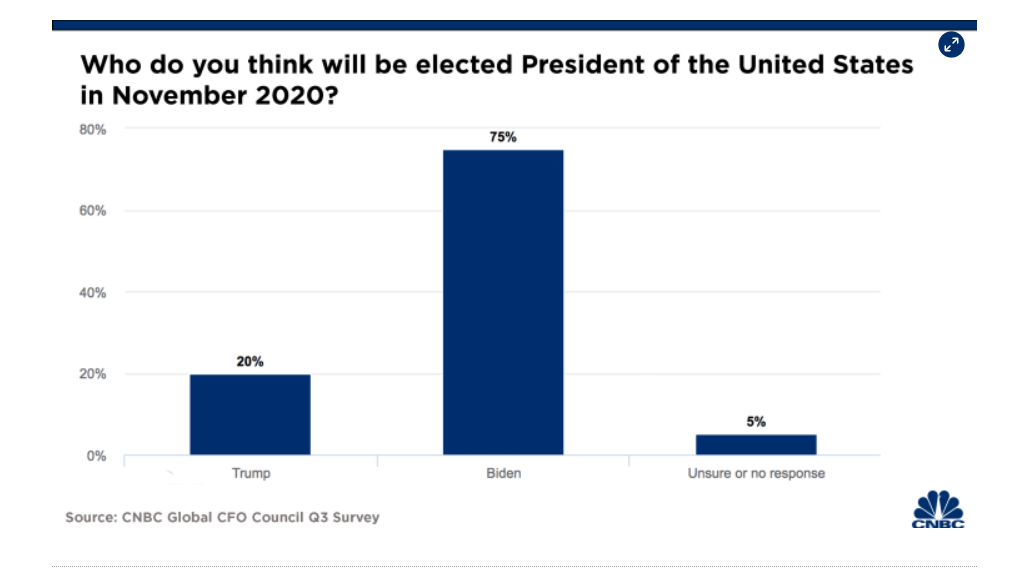
A struggling economy typically puts incumbent presidents at a disadvantage, but this election cycle is taking place in a relatively rare economic time as it will be only the third to take place during a formal recession since World War II. The previous two recession time elections were in 1948 when Harry Truman won reelection, and in 1980 when Jimmy Carter lost reelection.
Trump faces a true uphill battle when it comes to the election in the midst of this particular recession. That’s because this one is projected to be the worst since World War II with the global economy shrinking by 5.2% and the U.S. by 6.1% this year, according to the World Bank.12
US China tensions
The US and China have held talks over their so-called "phase-one" trade deal after the discussion was delayed earlier this month. Negotiations had been expected to take place on 15 August but were postponed by President Donald Trump.
No official reason was given for the postponement, although it had been reported it was to give Beijing more time to live up to its side of the bargain and to make more purchases of American grains and other commodities.
It marks a rare sign of co-operation between the world’s two largest economies, as their relationship has become increasingly strained this year over a wide range of issues including data security, the coronavirus pandemic and Hong Kong.11
The market appeared to ignore the latest sign of rising tension between the United States and China. The US on 26 Aug blacklisted 24 Chinese companies, including banning the short video-sharing app TikTok and social media platform WeChat, and targeted individuals over construction and military activity in the South China Sea.27
The increasingly fraught relationship between the United States and China could have negative economic consequences. After all, both the world’s two largest economies benefit from interaction. A reduction in such interaction will likely mean less trade, less cross-border investment, less sharing of ideas, higher costs, and ultimately slower economic growth.5
China
China is the only major economy expected to grow this year. Economists at the World Bank and elsewhere have also upgraded their forecasts for China. China's factories were also among the world's first to reopen in April, which helped China grab market share in global trade.13
China's economy has gradually emerged from a record contraction in the first quarter, but there are doubts if the momentum can be sustained, as rising coronavirus cases worldwide weigh on demand. Chinese consumption is also subdued amid job losses and concerns about a resurgence in infections.15
China's largest banks have already been leaned on by Beijing to prop up the economy. They've been told to pump cash out to small and medium-sized businesses and forgo profits by lowering interest rates and providing relief on trillions of yuan of troubled loans. Most recently, the government doubled down on pressure to get the major state-owned financial groups to cut salaries.
China’s mega banks are ramping up their recruitment of fresh graduates as a record number enter the labour market, joining other state-owned firms in boosting employment even as lenders deal with plunging earnings and ballooning bad debt. This is in direct response to the government's call to protect jobs.
Yet the tens of thousands of new jobs are but a drop in the bucket. The record 8.7 million of fresh graduates face the bleakest job prospects in decades as the global pandemic has pummeled domestic demand and exports. Unemployment for those of prime graduate age, 20 to 24, hovered at about 20 per cent in July, according to the country's statistics bureau.14
Europe
UK government debt has risen above £2 trillion for the first time amid heavy spending to support the economy amid the coronavirus pandemic. Spending on measures such as the furlough scheme means the debt figure now equals the value of everything the UK produces in a year. 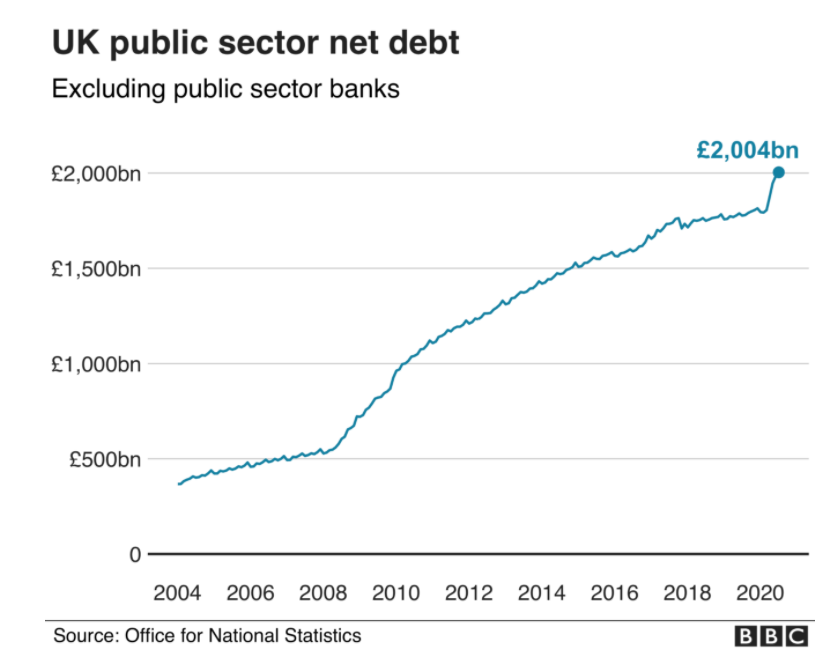
£2 trillion is, obviously, a large amount of money. But in the circumstances, it was inevitable that government debt would cross that threshold. Tax revenue has been hit hard by the pandemic as people and businesses earn and spend less. Government spending on programs such as the furlough scheme has headed upwards. So, the total amount owed has also increased, rapidly.16
However, on the bright side, The Office for National Statistics (ONS) said retail sales volumes rose by 3.6% between June and July. It said sales are now 3% higher than February before the World Health Organization declared a pandemic and the UK was placed in lockdown. Clothing sales grew last month and people spent more money on petrol. 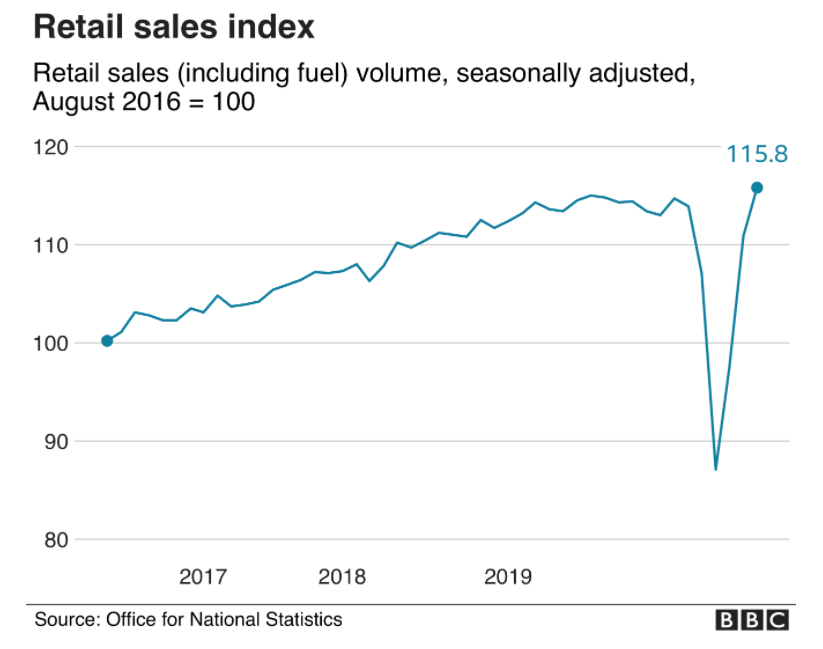
Meanwhile, activity in the UK's manufacturing and service sectors during August grew at the fastest rate for nearly seven years, according to a closely watched economic survey.
The IHS Markit/CIPS composite purchasing managers' index (PMI), which measures factors such as new orders and production, gave a preliminary reading of 60.3, the highest figure since October 2013. A figure above 50 indicates expansion.
While fuel sales rose by 26.2% between June and July, they remain far below pre-pandemic levels, down 11.7% compared with February.
With the UK now in a recession and many households likely to be tightening their belts as a result, spending on non-essential items may take a hit in the coming months, particularly as we approach the end of the furlough scheme in October.
The UK recorded its first recession since the financial crisis when the economy shrank by a record 20.4% between April and June compared to the first quarter of the year.17
Asia
According to the ANZ opportunity Asia report 2020, Asia will represent 40% of global consumption and 53% of GDP by 2040. Asia’s emerging economies are the only ones projected to maintain positive although subdued growth and on average businesses took 5 years to achieve positive returns from Asian expansion.18
Let’s take a look at how the emerging Asian economies are doing so far.
Vietnam
For the past three decades, Vietnam has been known for good economic news. The coronavirus pandemic changed all that. With garment companies seeing orders slashed and other sectors hit with sudden export declines, Vietnam’s workers are enduring the downside of being tethered to the global economy.
Vietnam has been one of globalization’s stars, transforming itself from a largely agricultural economy to a manufacturing powerhouse within the span of a few decades.
With exports equivalent to the size of its GDP, Vietnam has seen its economy grow as fast at 7.02% in 2019. Now it’s bracing for the slowest growth in two decades, of 2.4% this year. During the second quarter, it expanded by just 0.36% from a year earlier mainly due to their highly export-oriented nature thus resulting Vietnam to be vulnerable. 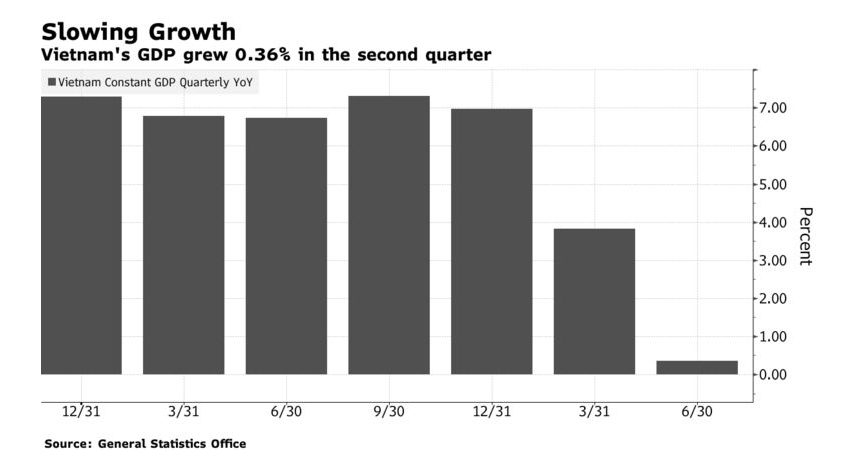
In April, Vietnam’s exports plummeted 14% from a year earlier, followed by a drop of 12.4% in May as global commerce came to a standstill, according to the Department of Vietnam Customs. For the seven months through July, exports rose just 1.5% compared with 8% in the same period last year.
The pace of Vietnam’s shipments to the U.S., its largest market representing about 23% of exports in 2019, slowed in the first half of 2020 compared with the same period last year. The government reported a 14.6% increase in exports to the U.S., about half the rate of shipment growth in 2019.
Many of the sectors that have been hard hit, such as garments and textiles, employ millions of low-skilled workers. Though Vietnam is in better shape than other economies in Asia, where the virus has been far more deadly and disruptive, its reliance on foreign markets and a growing tourism industry have given its residents a lesson in global volatility.19
Philippines
The Philippine economy shrank a record 16.5% in the second quarter, throwing the nation into a technical recession. The April-June gross domestic product figure covers economic activity during the peak of the initial lockdown to combat the spread of coronavirus, which was imposed in mid-March before being eased in June.
The economy contracted 0.7% in the quarter ended March, the first negative growth in two decades, putting the first-half contraction at 9% and pulling the plug on what was one of Southeast Asia's fastest-growing economies before the pandemic.22
Despite suffering a heavy blow from the Covid-19 pandemic, the construction industry in the Philippines is expected to bounce back in 2021 and grow at an annual average rate of 8.3 per cent from then till 2024, taking its output value up to US$75.1 billion that year.
The Philippines' construction industry had been the fastest-growing in Asia-Pacific before the pandemic but is now expected to contract by 9.2 per cent in 2020.In the second quarter, the industry contracted 33.5 per cent year on year, as construction activities were disrupted amid lockdown measures. On the brighter side, construction work has resumed since mid-May, and the resumption of infrastructure projects is meant to be a key driver in economic revival, not least with the US$18.9 billion Build, Build, Build (BBB) program that has been planned prior to the pandemic.20
Thailand
Thailand’s economy did not do as badly as expected in the second quarter, and the worst is likely to be over - though much weakness still lies ahead, said economists after official Q2 figures were released on Aug 17.
Gross domestic product (GDP) fell 12.2 per cent year on year in Q2, slightly better than the consensus expectation of a 13 per cent fall but marking the third straight quarter of contraction, and the sharpest decline since the Asian Financial Crisis.
On seasonally adjusted quarterly basis, GDP was down 9.7 per cent, deepening from the first quarter's 2 per cent fall. But recovery is still likely to remain gradual, given delayed reopening of borders affecting tourism which Thailand is highly dependent on and potential impact of rising unemployment and bad debts.
Trade signs are encouraging as China, South Korea and Singapore’s exports show signs of bottoming out, led by pharma and electronics shipments. Thailand will benefit not just from global economic recovery but also foreign direct investments, as supply chains shift away from China.21
Indonesia
Indonesia’s Q2 GDP shrank by 5.3% year-on-year, which is Indonesia’s weakest showing since Q1 1999, during the Asian Financial Crisis. The country’s central bank had meanwhile projected a contraction of 4.8% in Q2 against a 3% year-on-year growth in Q1.
The Covid-19 outbreak does not appear to be under control in Indonesia, with reports of new infections still trending higher. As a result, firms and households are likely to remain cautious in resuming economic activities.23
Trade on the other hand is looking positive for Indonesia with growth in exports driven by demand in China for nickel used in electric vehicles (EV) batteries. Government policies in Indonesia will remain focused on moving the mineral industry up the value chain in the coming years.24
Malaysia
Malaysia’s economy contracted 17.1% from April to June as compared to the year before due to movement control order (MCO) measures, which is the worst contraction in Malaysia’s history.
The severe downturn in Q2 as well as continuing restrictions on gatherings and people’s movements will continue to weigh on private consumption as disposable incomes shrink, and malls and entertainment venues see less traffic. Travel restrictions are likely to remain largely in place, as negotiations to re-open travel are likely to be limited to essential business travel in 2020. Malaysia will therefore be still unable to count on a return of tourism to aid the recovery, and this is a severe limiting factor, since tourism is a key part of the economy, accounting for 11.5 per cent of GDP (in both direct and indirect impact) in 2019.
A more synchronised global recovery in 2021 will help to spur external demand, and boost exports as there may be faster growth in imports as compared to exports due to “exuberance in private consumption’.25
Inflation
The Fed first pronounced a 2% target for inflation in 2012 but the Fed’s preferred measure of inflation has consistently fallen short, averaging just 1.4% since the target’s introduction.26 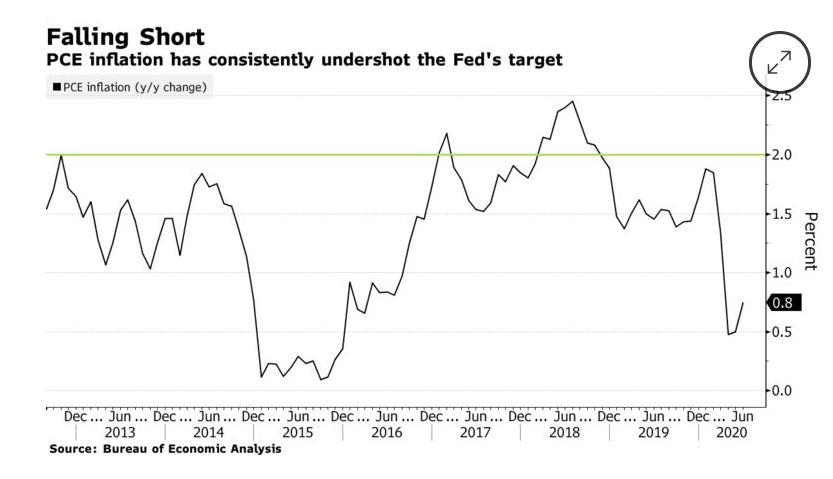
After Federal Reserve chairman Jerome Powell, announces its new inflation target, the US dollar gained on Thursday in choppy trading. The US dollar index initially sank on the announcement, before rebounding to last be up 0.53 per cent on the day at 93.31. Longer-term, if the Fed is able to increase price pressures but also leave rates near zero for longer, the policy would be negative for the US dollar.27
Impacts of Fed’s new policy
The Fed’s new policy ensures minuscule interest rates for years. While this, on the surface, appears good for business, it just may not be. For the past 18 months or more, historically low interest rates have created a mountain of debt in corporate America which will be an issue going forward. The new policy also impacts retirees and those baby-boomers nearing retirement. Their retirement savings, normally invested in safe-haven assets, now must seek more risky assets to throw off enough earnings for the retirees’ expected lifespans.
When uncertainty occurs, as it does every few years, the Fed is now obliged to print more money to support equities. Thus, it isn’t any wonder why the equity market keeps rising despite the historic new heights in risk ratios, like Price/Earnings, and junk bond yield spreads to Treasuries are at historic lows. Under these conditions, how long will it be before the world seeks a different reserve currency?9
Closer to our hearts
Singapore’s core inflation fell deeper into negative territory last month due to a steeper decline in the cost of electricity and gas, and lower inflation for non-cooked food. Core inflation, which excludes accommodation and private road transport costs, came in at minus 0.4 per cent in July, down from minus 0.2 per cent in June. This is the lowest since core inflation hit minus 0.5 per cent in January 2010. It was the sixth straight month of core consumer prices falling below the same period a year ago.
The cost of retail and other goods also recorded a smaller decline as the prices of telecommunication equipment rose and the fall in household durables and personal care product prices moderated.
The cost of electricity and gas saw a much sharper fall in July at negative 15.2 per cent, compared with minus 3.9 per cent in June, mainly due to a steeper decline in electricity prices as the electricity tariff was revised downwards. 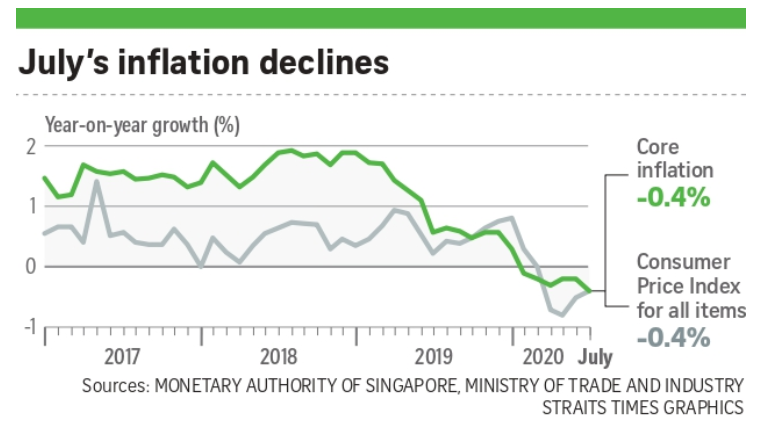
MAS and MTI noted that in the quarters ahead, external sources of inflation are likely to remain benign amid weak global demand conditions. MAS and MTI forecast core inflation and overall inflation to average between minus 1 per cent and 0 per cent this year.28
Crude oil
U.S. crude oil futures are trading slightly better on 28 August as Hurricane Laura moved beyond the heart of the U.S. oil industry in Louisiana and Texas without causing any major damage to production and refining facilities.29
U.S. crude oil exports to China grew by 139% in July thanks to bargain hunting among Chinese buyers, making the U.S. the fifth-largest supplier of oil to the critical Chinese market.
China’s top supplier of crude in July was Russia, which shipped 7.38 tons of crude to China in July, up by 30.1% on the year. Iraq came second, replacing Saudi Arabia and sending 5.788 tons of crude to China in July, a 35.7% annual increase. U.S. oil exports to China are likely to see a further boost. Bloomberg reported earlier this month that Chinese state energy companies had chartered tankers that can carry as much as 37 million barrels of crude for September shipments. This would be a record-high for China, despite the latest escalation between the two, and in accordance with its obligations under the trade deal closed last year.
China committed to buying some $18.5 billion in additional energy supplies from the United States this year and another $33.9 billion next year. The supplies range from crude oil and LNG to coal and oil products. However, the pandemic has shattered the demand that would have helped soak up these supplies, making it a lot harder than before for Beijing to stick to its commitment.30
As the markets gets more interesting to watch in the months to come due to the US presidential election and management of the second wave of the coronavirus in most countries, stay focused to your investment objectives, take a step back and look at this crisis as an opportunity that will not come by anytime soon again.
It is always good to always have a diversified approach to your portfolio and don’t forget to take profits along the way. Manage your emotions well in this crisis and you will be rewarded in time to come. A good approach to manage your emotions is by investing on a regular interval. dollarDEX allows you to setup Regular Savings Plan (RSP) with a monthly investment to the fund of your choice. Find out more here.
YOU MAY ALSO LIKE THIS
Sources:
2 https://www.telegraph.co.uk/business/2020/08/26/market-reportbull-run-drives-markets-record-high/ 3 https://www.cnbc.com/2020/08/24/economists-see-a-chance-of-a-double-dip-recession-survey-shows.html 4 https://www.wsj.com/articles/covid-crisis-drives-historic-drop-in-global-trade-11598368752 5 https://www2.deloitte.com/us/en/insights/economy/global-economic-outlook/weekly-update.html 6 https://www.ft.com/content/269eec67-1145-41b8-b97c-f43b293017fd 10 https://www.theguardian.com/us-news/2020/aug/29/us-presidential-election-biden-trump-coronavirus 11 https://www.bbc.com/news/business-53900054 13http://www.xinhuanet.com/english/2020-08/26/c_139317892.htm 16 https://www.bbc.com/news/business-53859299 17 https://www.bbc.com/news/business-53859148 21 https://www.businesstimes.com.sg/asean-business/thailands-122-fall-in-q2-gdp-marks-trough-economists 22 https://asia.nikkei.com/Economy/Philippines-plunges-into-recession-as-economy-shrinks-16.5-in-Q2 27 https://www.businesstimes.com.sg/companies-markets/us-dollar-gains-after-fed-shifts-inflation-target 29 https://oilprice.com/Energy/Energy-General/Is-A-Major-Oil-Price-Breakout-On-The-Horizon.html 30 https://oilprice.com/Latest-Energy-News/World-News/US-Oil-Exports-To-China-Soar-139-In-July.html 31 https://sg.news.yahoo.com/mutual-funds-facebook-amazon-apple-microsoft-google-problem-185739448.html
Disclaimer
All information here is for GENERAL INFORMATION only and does not take into account the specific investment objectives, financial situation or needs of any specific person or groups of persons. Prospective investors are advised to read a fund prospectus carefully before applying for any shares/units in unit trusts. The value of the units and the income from them may fall as well as rise. Unit trusts are subject to investment risks, including the possible loss of the principal amount invested. Investors investing in funds denominated in non-local currencies should be aware of the risk of exchange rate fluctuations that may cause a loss of principal. Past performance is not indicative of future performance. dollarDEX is affiliated with Aviva but dollarDEX does not receive any preferential rates for Aviva products as a result of this relationship. Unit trusts are not bank deposits nor are they guaranteed or insured by dollarDEX. Some unit trusts may not be offered to citizens of certain countries such as United States. Information obtained from third party sources have not been verified and we do not represent or warrant its accuracy, correctness or completeness. We bear no responsibility or liability for any error, omission or inaccuracy or for any loss or damage suffered by you or a third party (including indirect, consequential or incidental damages) arising in any way from relying on this information.
This information does not constitute an offer or solicitation of an offer to buy or sell any shares/units.
Information is correct as of 03/09/2020.
|




